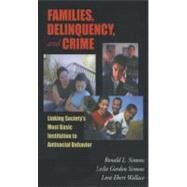Families, Delinquency, and Crime Linking Society's Most Basic Institution to Antisocial Behavior
, by Simons, Ronald L.; Simons, Leslie Gordon; Wallace, Lora Ebert- ISBN: 9780195330427 | 0195330420
- Cover: Paperback
- Copyright: 8/11/2004
This book explores the link between family life and antisocial behavior. In recent years, researchers from a variety of disciplines have investigated the relationship between society's most fundamental social institution--the family--and various forms of criminal behavior. Simons et al. fill a fundamental void in the literature by demonstrating how these seemingly disparate lines of research can be woven together using classic and contemporary theories of delinquency and crime. The book is designed to serve as a supplement for courses on juvenile delinquency, criminology, deviance, and child development. Families, Delinquency, and Crime evaluates and explores popular explanations using the results of studies by sociologists, criminologists, and psychologists. Each chapter succinctly defines terminology, establishes a review of empirical literature, and provides an effective argument that families are a dynamic aspect of our social lives that are intricately related to delinquency and other problem behaviors. Clear examples of each situation are provided. Part I explains child and adolescent antisocial behavior. The chapters review theory and research regarding the effect of family structure, marital conflict, parental antisocial behavior, and parents' childrearing practices on a child's risk for conduct problems and delinquency. Part II focuses on adult antisocial behavior and shows how the various family socialization processes and childhood behavior problems discussed in Part I influence the probability of later adult crime. Explanations are provided for both the continuity and discontinuity of antisocial behavior across the life course. Consideration is given to the manner in which romantic partners often modify deviant life course trajectories. The book also explores the link between family experiences during childhood and adult risk for either perpetrating or becoming the victim of marital violence.







